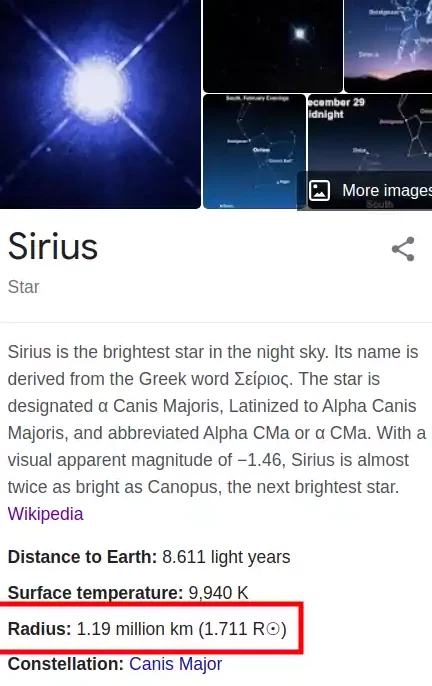Few stars receive names without any reference to their position within a constellation or in the sky as a whole. One of the most significant examples of this is the brightest star in Earth’s sky, Sirius. The name Sirius is believed to have originated from the Greek word Serios, meaning “burning” or “sultry”. This is often attributed to the fact that Sirius is visible in the night sky during the hottest period of the year (July-August), leading the ancients to speculate that the heat came not from the Sun, but from Sirius. Another theory suggests that since Sirius is the alpha star in the Canis Major constellation, it was also referred to as “dog” by the Greeks. This name was adopted by the Romans and scholars in the Arab world. Omar Khayyam referred to this star as the Dog of the Giant. The earliest version of this interpretation seems to be the mythical “hound of Indra”. However, we may question the origin of the name Sirius from the word “sultry” and consider a much older, pre-Roman origin for this name, similar to the pre-Greek origin of the name Orion. In this case, it would be logical to explore Proto-European and Sumerian roots.
The modern term tsar (also spelled czar) is commonly believed to be derived from the Byzantine word “Tsesar”, which is a fast pronunciation of the Latin word Caesar. Caesar, in turn, is the name of the Roman Emperor Gaius Julius Caesar. However, there are still two unanswered questions: first, the origin of the name Caesar itself, and second, the conformity of this etymological construction to the principle of speech evolution, which suggests that longer words and names are derived from simpler, one-syllable ones. Therefore, instead of relying on the typical legend of the onomastic circle, we need to search for the real origins of the word. By looking at the history of the name Orion, we can draw parallels to the Sumerian word Sar, meaning “lord” or “master”, which could be one of the main ancestors of the word “king”. Additionally, in the Rigveda, the dog who serves as Indra’s messenger is named SARama, which may hold the key to understanding the origin of the name Sirius.
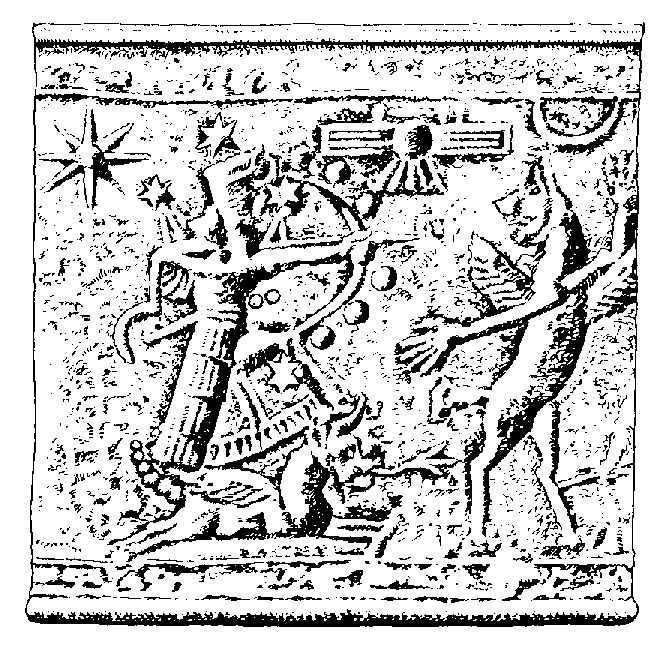
The ancient Babylonians portrayed Orion as Nimrod, the divine hunter, who was accompanied by a winged dog. According to legend, Nimrod played a significant role in the construction of the Tower of Babel.
It is important to note that in ancient times on the vast Eurasian steppes, it was the dog, not the lion, that was considered the ruler of the animal kingdom. The dog was the first domesticated animal, assisting man, the “king of nature,” in hunting and herding. It is only fitting that a royal animal would be next to Indra, the “king of gods” and “king of the entire universe.” Furthermore, in Sanskrit, the language closest to the Rigveda, the word “siar,” from which the name Sirius is sometimes derived, carries the meanings of “shine” and “luminous” – words traditionally associated with royalty – rather than “sultry” or “burning.”
Of particular interest lies in the second component of the compound term Sarama – the root “ma”, which is universally associated with motherhood in all Indo-European languages. It is impossible not to recall the Roman legend of the Capitoline she-wolf, who nurtured Romulus and Remus, the ancient Iranian legend of the she-wolf who nourished the great king Cyrus, and the legendary origin of all Turks from a boy nourished by the same she-wolf. Additionally, the mythological tradition consistently portrays the wolf as closely related to a divine dog or god. The presence of two wolves, always accompanying the Scandinavian god Odin as his “dogs”, directly connects us to the cosmic Orion, accompanied by the Great and Little Dog. In this context, it can be confidently inferred that Sarama can be seen as a “regal caretaker” who nourished ancient man, either literally or indirectly through her indispensable assistance in hunting and safeguarding the herd.
Which notable names are connected with the root sar/tsar and have been preserved in history in the region adjacent to the southwest of the “earthly Indra”? First and foremost, we should recall Sarmatia – an ancient and medieval name commonly used for the Azov lands. This name is almost identical to the divine SARAMA, with the only difference being the omission of one letter “a” when adding the ending “tia” (the possible meaning of which will be discussed later)! Additionally, according to Herodotus, it was in this region that the CAR Scythians – “the bravest and largest tribe of Scythians” – resided.
According to the aforementioned information, we can deduce that the name Sirius should primarily be interpreted as the King Star, which is a fitting title for the brightest star in the celestial sphere. When considering its earthly counterpart, it should hold a position of similar “royal status”. The prime candidate for this role is none other than the renowned Tsar Grad – “the capital of the Universe”. However, we are not referring solely to the Tsargrad of the Middle Ages, known to us as Constantinople, but possibly to another, much older city, the memory of which has nearly faded away. Only faint recollections remain, painstakingly reconstructed based on the ancient Indo-European myths. Without delving into intricate details, it is worth mentioning that it is highly probable that this city was situated at the mouth of the prehistoric Don River, specifically in the region of the Black Sea that lies in close proximity to the Kerch Strait. These submerged territories were inundated approximately five millennia ago when the waters of the Mediterranean Sea breached into the Black Sea, causing the latter’s water level to rise by almost a hundred meters. This calamity resulted in the flooding of extensive regions in the northern part of the Black Sea and the formation of the present-day Sea of Azov. The recollection of these events likely gave rise to the famous legend of Atlantis, as well as the tales of the submersion of “beautiful Dvaraka,” the city of Krishna, and “great Tripura,” the city of the Asuras, in the ancient Indian myths from the Rigveda period. Among the Slavic peoples, remnants of these memories are most vividly seen in the enigmatic legend of the illustrious city of Kitezh.

Terrestrial equivalents of the “Celestial Empire”
True in the latter case, two important explanations are needed. First, in order to interpret it this way, we must assume that the starry sky is projected on Earth at 2 times smaller scale, which is quite reasonable, as ancient Babylonian beliefs considered the heavenly temple to be twice as large as the earthly one, and adjustments were made to ensure proper correspondences [12, p. 653]. Second, in later legends, Kitezh is said to be located in the Trans-Volga forests, northeast of the Volga-Don X-shaped convergence, where there are no real traces of a sunken city in Lake Svetloyar or any other lake. This misunderstanding is likely a result of a peculiar inversion during a certain historical period regarding the position of the “earthly Indra”. There are compelling reasons to believe that this inversion occurred during the post-flood period when the primary Tsar Grad appeared under the waters of the Black Sea, and in ancient mythological consciousness, the “river Indra” was already situated to the south. From the pre-flood era, the name Kitey remained, which referred to a large ancient city on the Kerch Peninsula, located in the area closest to the mouth of the pre-flood Don. The ruins of this city, partially excavated by archaeologists, are now mostly underwater. “Kitezh, the city of Aya”, “the solid land of Kitezh”, and “the Kitean region” are mentioned multiple times by both Herodotus (5th century BC) and Apollonius of Rhodes (3rd century BC) in the epic poem “Argonautica”.
The origin of the names Kitezh and Kitei is likely directly linked to the Sumerian term “Ki”, which referred to both the entirety of the earth (while “An” referred to the sky, and the combination “A-Ki-An” meant neither the earth nor the sky, i.e., the ocean) and a specific area, location, or district on the earth. For instance, the area with the highest concentration of Sumerian cities by their inhabitants was known as Ki-Sumer, which ultimately gave its name to the entire renowned civilization. Similarly, Kiev – “the mother of Russian cities” – most likely derives its name from this ancient root rather than a specific individual. And just as Orion simply means “constellation,” Kiev probably means simply “city,” as the primary and most significant among the remaining ancient cities.
The name KI-shu-MER (or KI-su-MER) combined with the widely accepted idea that the Sumerians in Mesopotamia, like the Aryan tribes in India, were extraterrestrial beings, brings to mind the enigmatic KIMERians, who, according to legend, were displaced from the Azov region by the Scythians but left their mark in the names of the Bosporus Cimmerian and the river Samara. Adding to this the name of the semi-legendary founder of the Iranian power KIMMARS [5, p. 23], and the fact that Homer’s epic mentions the Cimmerians, who resided in Crimea, it is plausible to assume that the Cimmerians/Sumerians were among the original inhabitants of “pre-flood Kitea” and were displaced either directly by a catastrophic natural disaster or by the ensuing social upheaval. Thus, in legendary accounts, they transformed into a people who supposedly preceded the Scythians of Herodotus’ time. In this context, the well-known ancient phrase “the darkness of Cimmerian” may symbolize the depth of the memories associated with this concept, reaching back into the “darkness of millennia”.
Further attention should be given to the issue of Kitezh. Recent research has shown that among all European languages, the East Slavic languages – Russian, Ukrainian, and Belarusian – have the most similarities with Rigveda. This correlation has also been noted in relation to the Scythian language. Linguistic remnants, attributed to the specific historical development, are particularly prominent in the Ukrainian language, which was first recognized in the previous century. It is worth noting that in Ukrainian, the name of Scythia/Rus is pronounced as Scythia, which could be a shortened version of the original “So-Kytia”, referring to the land adjacent to Kitei/Kitezh. The word Kitei itself can be broken down into two syllables – Ki and Tei. The meaning of the first syllable has already been discussed, while the meaning of the second syllable can be linked to the ancient Greek root “theos”, meaning god. Therefore, the overall semantic interpretation can be seen as “divine land”, which aligns with the notion of Holy Russia. Additionally, the name Sarmatia, in this context, can be understood as “divine royal nurse”, which aptly describes the lands renowned for their fertile black soil and abundant pastures.
Further Reading
Oedipus Rex
Oedipus Rex, also known as Oedipus the King, is a famous tragedy written by R. K. What can you remember about the events that triggered the creation of Oedipus Rex? How extensive was the partnership between R. K. and Cocteau in terms of scripting and text development? Why was the decision made to translate the libretto into Latin, and why specifically Latin as the chosen language?
Star of the Mother of the World
The constellation known as the Seven Sisters, or the Seven Elders, or the Big Dipper, holds a significant place in the collective consciousness of humanity. It has been revered in various religions and cultures throughout history. The Bible, for example, contains passages that glorify this constellation. Similarly, the Buddhist sacred Tripitaka includes a lengthy prayer dedicated to it. The ancient Mayans also held this constellation in high regard.
Star of the Mother of the World
The Seven Sisters, also known as Seven Elders or the Big Dipper, have captivated the attention of humanity. This constellation holds great significance in various religious texts, such as the Bible and the Buddhist sacred Tripitaka. It was also revered by the ancient Mayans and
King Solomon
King Solomon continues to soar over the expansive landscapes of Asia on his extraordinary flying contraption. Numerous mountains throughout Asia bear the remnants of the great king, whether it be ancient ruins or stones marked with his footprints and the impressions of his knees, evidence of his lengthy prayers. These are often referred to as
“STAR OF REDEMPTION.”
“STAR OF REDEMPTION” is a significant work by Rosenzweig, which stands as a crucial testament to Judaic modernism. (Z.I. is the symbol of the Star of David, forming a harmonious whole.) It presents an intricate interpretation of the philosophical embodiment of the ultimate goal of redemption.
KING HARSHA
KING HARSHA If the descriptions of India’s mental state during Xuan-tsang’s visit and stay at the court of Harsha appear to be exaggerated from the perspective of a Buddhist priest, we can refer to Bana’s Sanskrit story of Harsha for a different perspective.
THE CHERISHED STAR
THE CEREDITAL STAR When Gautama Buddha attained enlightenment, it happened on a full moon night. All his concerns and worries vanished, as if they had never existed, as if he had just woken up from sleep. The questions that had troubled him before naturally faded away, and he experienced a sense of ultimate clarity and peace.
“The Guiding Light of Your Fate”
“The guiding light of your fate” The concept of the collective unconscious is among those scientific ideas that initially seem unfamiliar to the general public, but soon become well-known and even popular. A similar phenomenon occurred with…
Shimmering celestial body
Shimmering Celestial Body Plato, citing an Egyptian priest, stated that the world’s fiery phenomenon associated with Phaeton was caused by the collision of heavenly objects orbiting the Earth. Based on our understanding, it is likely that the comet Venus was responsible for this event, which occurred over two
Celestial body. Lesson thirty-six
Celestial Body. Lesson Thirty-sixth The endowment of speech presents us with unique words, “piece”, which have a distinct meaning and sound, excluding any derivative forms. Moreover, these words have remained largely unaffected by the passage of time, the influence of various ideologies, and have retained their original sound
Red Star
Red Star (a novel-utopia)8
The Star of Enchanting Dreams
The Star of Enchanting Dream Now, my dear reader, just imagine the alluring vision of the future that we can offer not only to the Russians, but to all the people of the future USSR-2. But not just them? To the people of the entire Earth! And what is an ideal of astonishingly appealing strength? It is half the battle.
While learning to draw a KOTYONKA, I have been searching for this particular post for a considerable amount of time. Finally, I have found it and now I wish to share it with you.
CUCKLOVODES OF THE WORLD ZAKULISA: 5 MOST HISTORIC GRAY CARDINALS IN HISTORY Unremarkable figures, co.
Have you ever heard of the eighth wonder of the world – the Great Man-Made River? Who constructed it? The construction.
“Pre-scientific” view of the world – belief in sorcerers and witchcraft “Pre-scientific” to.
–Summary
Irina Alexandrovna
–Search through diary
–Subscribe via email
–Topics
- Embroidery (171)
- Beads (55)
- Embroidery on knitted fabric, ribbon embroidery (96)
- Dinner is served. (323)
- Pastries (25)
- Meat, poultry (23)
- Salads (14)
- Sauces, gravies, dressings (12)
- Soups (4)
- Design, interior (138)
- Ideas for gardeners (102)
- Interior of the house, room, kitchen. (43)
- For knitting enthusiasts (3593)
- Blouses, crochet and needlework tops (401)
- Pants, skirts, shorts, suits (37)
- Knitting Videos (42)
- Knitting for Kids (752)
- Knitted Jewelry: Necklaces, Necklaces, Bracelets (47)
- Dressing Tips for Elegant Ladies or How to Style a Curvy Girl (27)
- Lace (106)
- Small Home Decor Items (74)
- Men’s Fashion (13)
- Crochet Dresses (98)
- Knitted Dresses (93)
- Helpful Knitting Tips (227)
- Crochet Patterns (186)
- Crochet Patterns (153)
- Crochet and Needlework Lessons (149)
- Crochet Patterns (4)
- Crochet Patterns (11)
- Bowler Hats (87)
- Exclusive Knitting Designs (263)
- Caring for the Elderly (31)
- Law and Order (448)
- Housing and Utilities (14)
- Earning Money Online or How to Avoid Being Scammed (29)
- Politics and Politicians (200)
- Current World Events (308)
- Health Tips (196)
- Movies (25)
- Stunning Photographs (124)
- The Enchantment of Gemstones (50)
- The Magic of Imagination (184)
- Various Forms of Creativity (48)
- Parables, Stories, Legends, Histories (207)
- Fascinating Short Stories (116)
- A Story with a Moral (48)
- Tales from the World of Elfika (8)
- FASHION (and Everything About Fashion) (114)
- Wisdom from the Sages of the World (504)
- Inspirational Quotes, Sayings, and Advice from the Famous (227)
- Psychology, Esoterics (222)
- For Gentlemen (68)
- For the Homemaker (46)
- Us and Our Children (874)
- Education (327)
- Fairy Tales and Stories (7)
- Do It Yourself, Do It With Kids (158)
- Games, Cartoons, Movies (21)
- How to Sketch with a Pencil (68)
- How to Paint with Colors (30)
- Pergamano (16)
- Handicrafts (118)
- Russian language (91)
- Stencils (3)
- Drawing Lessons for Children and Adults (253)
- I learn to draw with pencils and paints (personal) (7)
- Nature (887)
- Trees, forests, groves (1)
- Traveling (100)
- Traveling the World on the Internet (35)
- Works of various artists (549)
- Watercolor, oil, pencil (364)
- Painting videos (5)
- Paintings from past centuries (116)
- Animals, birds (54)
- Pictures, animation, holidays (87)
- Portraits (90)
- Nature, village (62)
- Drawings in simple pencil by different artists (7)
- Artists discussing children (96)
- Flowers, still lifes (54)
- Computers and their programs (278)
- HTML – a collection of quick reference guides, codes, snippets, buttons, and images (27)
- Image Generators, Photography (16)
- Text Generators (3)
- How to capture a screen (8)
- Keyboard – keyboards or hotkeys (12)
- Photoshop (58)
- Quick reference guides (57)
- Religion (482)
- The Bible (how it is used by people) (275)
- The Quran (15)
- All About Prayers (10)
- Comprehend and apply your knowledge (236)
- Galaxies, Universe, Space (55)
- Other, diverse religions (239)
- Icons (42)
- Judaism (217)
- Holidays, beliefs, rituals, customs (153)
- Satanism and the interpretation of biblical “flights” (192)
- Temples, cathedrals, churches (73)
- Russia (340)
- History of the Yusupov Family (16)
- How it used to be. and what it can become. (59)
- Moscow (past and present, its history and stories) (56)
- Romanovs (interesting historical facts) (13)
- That Which Must Never Be Forgotten (67)
- Poems that I enjoy (176)
- Irina Samarina-Labyrinth (8)
- Lessons on creating a diary on LiRu (122)
- What to give to you, my dear man. (5)
- Humor (103)
–Tags
–Applications
- Always AccessibleNo comparable alternatives ^_^ Allows you to add a section with customized HTML code to your profile. You can place banners, counters, and other content there
- E-cardsA revamped collection of e-cards for all occasions.
- Blog DirectoryOrganize blogs of individuals and communities by categories, making it easier to find the desired and interesting blogs among the vast number of blogs on li.ru.
 ConverterCase Converter
ConverterCase Converter- TorrNADO – Blog Torrent TrackerTorrNADO – Blog Torrent Tracker
–Always within reach
–Interests
–Companions
–Loyal followers
–Communities
–Metrics
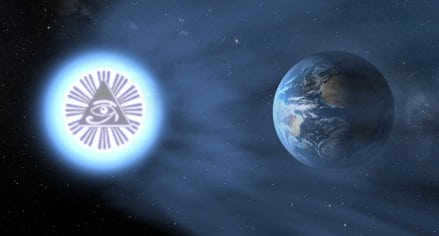

Throughout the ages and across numerous civilizations, Sirius, also known as the dog star, has been enveloped in a veil of enigmatic tales. Esoteric wisdom from various eras consistently attributes a unique significance to Sirius, and the star’s presence in occult imagery serves as a testament to this fact. What sets Sirius apart? Is it solely due to its status as the brightest star in the night sky? Or is there something more, a clandestine connection between humanity and this ancient celestial body? This article delves into the historical and secretive associations of Sirius, exploring the symbolism that surrounds it.
Sirius is located in the constellation Canis Major, which is also referred to as the Big Dog, earning Sirius the nickname “dog star”. This star shines twenty times brighter than our Sun and is twice as massive. During the night, Sirius stands out as the most luminous star in the celestial sphere, and its brilliant blue-white radiance has captivated astronomers for ages. It’s no surprise that Sirius holds great significance in numerous ancient civilizations. But is there a hidden side to Sirius that remains undiscovered?

Historical evidence suggests that civilizations of the past have recognized the significant role played by Sirius in the fields of astronomy, mythology, and occultism.
Ancient teachings refer to it as the “sun behind the sun,” representing the ultimate source of energy for our own sun. While our sun provides the necessary heat to sustain life on Earth, Sirius is believed to sustain the spiritual realm. It is described as the “true light” that shines from the East, symbolizing spiritual illumination, while the sun merely illuminates the physical world, which is perceived as an elaborate illusion.
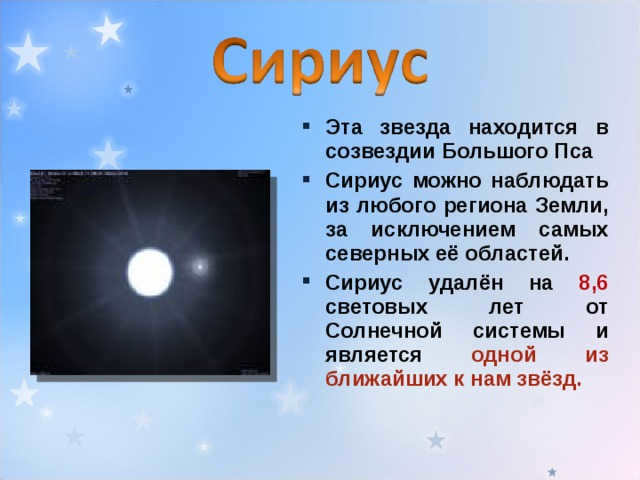
The connection between Sirius and the divine, as well as the belief that it serves as the dwelling place of the “great teachers” of humanity, is not only present in the mythologies of various ancient civilizations, but also persists (and even grows stronger) in contemporary times. In this article, we will explore the significance of Sirius in the ancient world, delve into its prominent role within secret societies, and examine how these esoteric concepts have influenced popular culture.
In ancient civilizations.
In the ancient Egyptian culture, the star known as Sirius held great significance. It was considered the most important star in the sky and played a crucial role in the religious beliefs of the Egyptians. This star, also known as Sothis, was closely associated with Isis, the mother goddess of Egyptian mythology.
Isis, along with her husband Osiris and their son Horus, formed a trinity in the ancient Egyptian pantheon. Sirius was held in such high regard by the Egyptians that many of their deities were connected to it in some way. For example, Anubis, the god of death, who had the head of a dog, was clearly associated with the star. Additionally, Thoth-Hermes, the revered teacher of humanity, was also believed to have a hidden connection to Sirius.
The Egyptian calendar system was established based on the heliacal rising of Sirius, which occurred just before the annual flooding of the Nile during the summer months. This celestial movement of the star was also observed and respected by various ancient civilizations, including the Greeks, Sumerians, Babylonians, and others. As a result, this star held great significance and its appearance in the sky was accompanied by festive events and celebrations. The Dog Star’s presence heralded the arrival of the hot and dry days of July and August, hence the popular phrase “dog days of summer”.
According to some occult researchers, the Great Pyramid at Giza was meticulously constructed in alignment with the stars, particularly Sirius.
“The Egyptians of ancient times were aware that once a year, the Sun and the Dog Star align. As a result, they designed the Great Pyramid in such a way that during this sacred moment, the light from the Dog Star would shine upon the square ‘God Stone’ located at the top of the Great Gallery. This light would then descend upon the head of the High Priest, who had received the Super Solar Power and was using his enhanced Solar Body to transmit this additional stimulation to the other Devotees, aiding in their spiritual development. This was the purpose of the ‘Stone of God’ upon which the Ritual of Osiris was performed, symbolizing the bestowal of heavenly light.” “The crown of Atf.” “North and south of this crown is love,” as proclaimed in an Egyptian hymn. The visible light was but a shadow of the invisible light in Egyptian teachings, and the measures of Truth were the years of the Most High in their ancient wisdom.” [1. Marshall Adams, The Book of the Master.] Recent scientific discoveries regarding the Great Pyramid and its enigmatic “air shafts” have further emphasized the significance of Sirius in the pyramid.
The Great Pyramid of Giza exhibits a remarkable correlation with the arrangement of stars in the sky. The King’s Chamber, symbolizing the god Osiris, is precisely aligned with the constellation Orion, while the Queen’s Chamber, representing the goddess Isis, is perfectly aligned with the star Sirius.
The symbolism and meanings associated with Sirius are truly captivating. Throughout history, various civilizations have connected Sirius with a dog-like figure, attributing mysterious power to this celestial body. In the realms of Chinese and Japanese astronomy, Sirius is referred to as the “celestial wolf star”. Similarly, several aboriginal tribes in North America have described Sirius in canine terms. For instance, the Seri and Tohono O’Dham tribes of the Southwest view Sirius as “the dog that follows the mountain sheep”, while the Blackfeet refer to it as “Dogface”. The Cherokee believed that Sirius, alongside Antares, served as the guardian of the Path of Souls. In Nebraska, the Wolf (Skidi) tribe recognized Sirius as the “Wolf Star”, while other branches knew it as the “Coyote Star”. Further north, the Bering Strait Inuit of Alaska called it the “Moon Dog”. [2. J. B. Holberg, Sirius: the brightest diamond in the night sky.]
In 1971, a controversial book titled The Mystery of Sirius was published by American writer Robert Temple. In the book, Temple asserted that the Dogon, an ancient tribe from Mali, possessed knowledge about Sirius that could only be obtained through the use of telescopes (such as the one depicted here, resembling Orion). 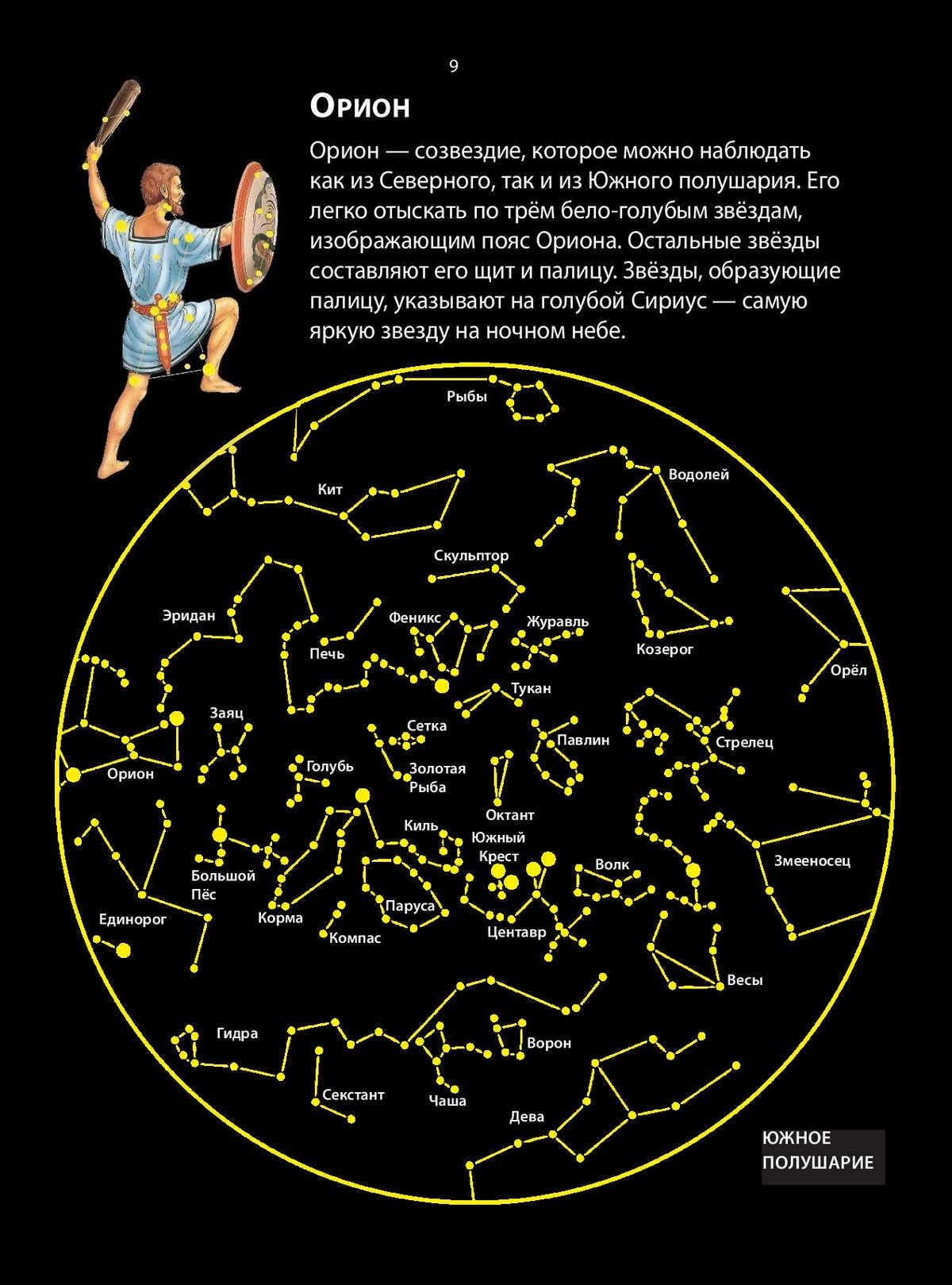
According to Temple, the Dogon tribe understood that Sirius is actually a binary system comprised of two stars known as Sirius A and Sirius B. As a result, Temple concluded that the Dogon had a “direct” connection to extraterrestrial beings from Sirius. While some may make light of this claim and say, “You can’t be Sirius” (pardon the pun), it is worth noting that numerous secret societies and belief systems throughout history have taught about the mystical link between Sirius and humanity. 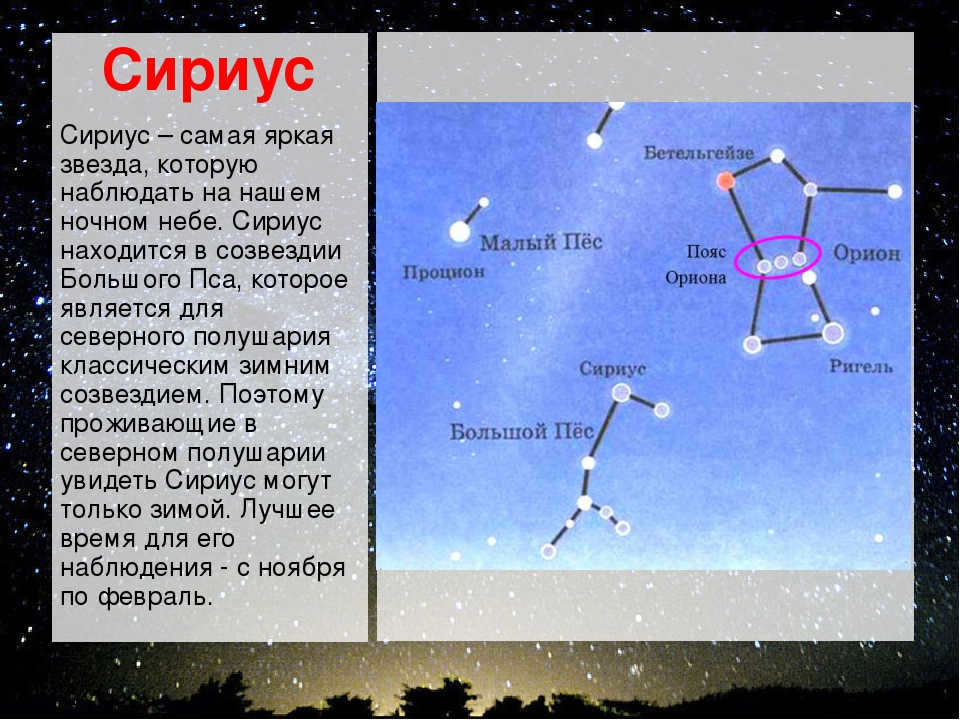
According to the Dogon mythology, it is believed that the human race originated from the Nommo, a species of amphibians that inhabited a planet orbiting Sirius. According to the myth, they came to Earth in a fiery and thunderous vessel from the sky and shared profound knowledge with humans. This gave rise to Robert Temple’s hypothesis that the Nommos were extraterrestrial beings from Sirius who visited Earth in ancient times to enlighten civilizations like the Egyptians and the Dogon people about the Sirius star system and our own solar system. These civilizations then incorporated the teachings of the Nommos into their religions and made them the central focus of their Mysteries.
The mythology system of the Dogon tribe shares striking similarities with other ancient civilizations such as the Sumerians, Egyptians, Israelites, and Babylonians. These similarities can be seen in their shared belief in the archetype of the “great teacher from above”.
Across different civilizations, this great teacher is known by various names, including Enoch, Thoth, or Hermes Trismegistus, as mentioned in the Bible and apocryphal writings. It is believed that this teacher imparted the knowledge of theurgic sciences to humanity.
In esoteric traditions, it is widely believed that Thoth-Hermes imparted his wisdom to the inhabitants of Atlantis, an ancient civilization that, according to mythology, reached unparalleled advancements before being submerged by a cataclysmic flood (similar flood narratives can be found in the mythologies of numerous cultures). Following the destruction of Atlantis, survivors embarked on sea voyages to various lands, including Egypt, where they shared their highly developed knowledge.
"Could it be that the religious, philosophical, and scientific knowledge possessed by the ancient priests was derived from Atlantis, whose demise obliterated all signs of its significant role in the progress of humanity?
The reverence for the sun in Atlantis was continued through the rituals and ceremonies of both Christianity and paganism. The cross and the serpent were both symbols representing the divine wisdom of the Atlanteans. The divine ancestors of the Maya and Quiché people of Central America coexisted in the vibrant green and blue glow of Hucumatz, the “feathered” serpent. The six celestial sages appeared as sources of light, united and harmonized by the seventh – and most important – member of their group, the “feathered” serpent. The title “winged” or “feathered” serpent was given to Quetzalcoatl, or Kukulcan, who was worshipped in Central America. The heart of the Atlantean Wisdom-Religion was seemingly a large pyramidal temple located on a high plateau in the middle of the Golden Gate City. From here, the Devoted Priests of the Sacred Feather came forth, carrying the keys of Universal Wisdom to the farthest corners of the world.
The world inherited more than just arts and crafts, philosophy and science, ethics and religion from the Atlanteans. They also passed down a legacy of hatred, conflict, and perversity. It is believed that the Atlanteans were responsible for initiating the first war, and all subsequent wars have been futile attempts to justify and rectify the wrongs of that initial conflict. Recognizing that Atlantis was doomed due to its deviation from the Path of Light, spiritually enlightened Initiates departed the sinking continent. These Atlanteans brought their sacred and secretive teachings with them to Egypt, where they became the first “divine” rulers. Many of the world’s sacred texts are rooted in the cosmological myths of the Atlantean Mystery rituals. [3. Helena Blavatsky, Theosophical Dictionary]
Is Thoth-Hermes-Trismegistus comparable to the nomos of the Dogonians, who are thought to have originated from Sirius? Ancient writings about Hermes portray him as a celestial instructor of the enigmatic knowledge “who originated from the celestial bodies”. Moreover, Thoth-Hermes was closely associated with Sirius in the Egyptian mythos.
“The Dog-star is a star that was worshipped in Egypt and revered by those practicing the occult. The Egyptians worshipped it because its rising with the Sun signaled the beneficial flooding of the Nile, while occultists saw it as mysteriously linked to Thoth-Hermes, the god of wisdom, and Mercury in another form. This means that Sotis-Sirius has always had a mystical and direct influence over the celestial bodies and is associated with almost every god and goddess. It was referred to as “Isis in the heavens” and was named Isis-Sotis because Isis was “in the constellation of the dog,” as stated on her monuments. Due to its association with the Pyramid, Sirius was also tied to the initiations that took place there.” [4. Helena Blavatsky, Theosophical Dictionary]
“The ancient Egyptian text, ‘The Virgin of the World,’ makes mention of the ‘Black Rite’ associated with the enigmatic figure of Osiris, as the highest level of secret initiation in their religion. This mysterious rite, considered the ultimate secret of the Isis Mystery, is said to be encoded in the celestial secrets Hermes left behind when he ascended back to the stars after teaching civilization to humanity on Earth” [5. Robert Temple, The Mystery of Sirius].
While proving its connection is challenging, the symbolic association between Sirius and esoteric knowledge has persisted throughout history, transcending time and generations.
Contemporary clandestine organizations like the Freemasons, the Rosicrucians, and the Golden Dawn (which fall under the category of Hermetic Orders as they draw upon the teachings of Hermes Trismegistus) assign great significance to Sirius. An examination of their symbolism sheds light on Sirius’ profound link to esoteric philosophy.
To state that Sirius is “significant” to the Hermetic Orders would be an understatement. The Dog Star serves as nothing less than the focal point of these secret societies’ teachings and symbolism. Clear evidence of this can be found in the fact that numerous secret societies are actually named after the star.


“The seventeenth numbered major arcana card is known as Les Étoiles (French for ‘The Star’), featuring a youthful girl in a kneeling position with one foot immersed in water and the other resting on the ground, resembling a swastika. She holds two urns, pouring their contents onto the land and sea. Positioned above the girl’s head are eight stars, with one particularly large and brilliant.”
Count de Goebelen identifies the primary celestial body as Sotis, more commonly known as Sirius, while the remaining seven are considered the revered planets of ancient times. He posits that the female form depicted represents Isis, the goddess responsible for the flooding of the Nile, which coincided with the appearance of the Dog Star. The depiction of Isis in a disrobed state likely symbolizes the notion that Nature does not flourish until the rising waters of the Nile unleash the vital essence of plants and flowers."- Manley P. Hall, "Secret Teachings of All Ages."
In Freemasonry, the star Sirius holds a significant position and is referred to as the “Blazing Star.” Its importance is evident in its prominent role in Masonic symbolism. According to Masonic writer William Hutchinson, Sirius is “the first and most exalted object that demands our attention in the Lodge.” Just as the light of Sirius was believed to enter the Great Pyramid during initiations, its symbolic presence can be found in Masonic Lodges.
Albert Pike, in his work “Morality and Dogma,” states, “The ancient astronomers recognized the great symbols of Freemasonry in the stars. Sirius shines in our lodges as the Blazing Star.”
Sirius (known as Sirius in Latin) is a star located in the constellation of Canis Major, also known as the Big Dog. It is classified as a main sequence star with a spectral class of A1. Sirius holds the distinction of being the brightest star in the night sky, with a luminosity 25 times greater than that of the Sun. However, its apparent brightness is largely due to its close proximity to Earth, rather than its intrinsic luminosity. Sirius can be seen from any part of the Earth, except for the most northern regions. It is situated approximately 8.6 light-years away from our solar system, making it one of the closest stars to Earth. In 1844, Friedrich Bessel proposed the idea that Sirius is actually a binary star system. This hypothesis was confirmed in 1862 when Alvan Clarke discovered a companion star, now known as Sirius B. As a result, the star visible to the naked eye is sometimes referred to as Sirius A. The two stars in the Sirius system orbit around a common center of mass, with an average distance of about 20 astronomical units and an orbital period of approximately 50 years. In 1915, astronomers at the Mount Wilson Observatory determined that Sirius B is a white dwarf, making it the first white dwarf to be identified. This finding suggests that Sirius B must have been more massive than Sirius A in the past, as it has already evolved off the main sequence (known as Algol’s paradox). The current estimated age of the Sirius system is around 230 million years, although estimates range from 200 to 300 million years. Originally, the Sirius system consisted of two blue-white stars with spectral class B. Sirius A had a mass of 2 solar masses (M☉), while Sirius B had a mass of 5 M☉. Roughly 120 million years ago, Sirius B exhausted its nuclear fuel and expanded into a red giant, shedding its outer layers and transitioning into its current white dwarf state. Today, Sirius B has a mass of approximately 1.02 M☉, making it one of the heaviest known white dwarfs (typical white dwarfs have masses ranging from 0.5 to 0.6 M☉).
Table of Contents
Historical Overview [ edit edit code ]
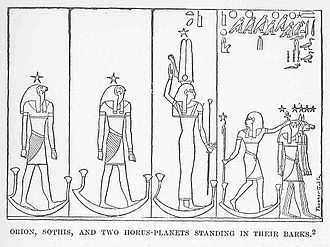
In ancient Sumerian and Akkadian astronomy, the star was known as Arrow and was linked to the deity Ninurta [18]. According to the inscription on the monument of Tiglath-Pileser I (11th century BC), it is mentioned that “during the cold, frosty days, when the star Arrow appears, it shines like fiery red copper,” referring to the heliacal rising of Sirius, which occurred in the middle of winter during the Middle and New Assyrian periods [19].
The present-day name Sirius is derived from the Latin spelling Sirius, which is a transcription of the Greek Σείριος (meaning “bright” or “brilliant”). Since ancient times, Sirius and Procyon have been referred to as the dog stars [20].
As per the legends of Greek mythology, Sirius was regarded as the dog star belonging to Orion or Icaria. In the renowned epic poem “Iliad” (XXII 30), Homer mentions it as “Orion’s dog”. The ancient Greeks also linked Sirius with the scorching summer heat, as the name of the star is derived from a word denoting a “hot day”. According to Aratus, a Greek poet from the 3rd century BC, Sirius earned this name due to its dazzlingly radiant brightness [21].
The star was also known by its Latin name Canicula, which translates to “little dog, doggie”. In ancient Rome, the period of intense summer heat, coinciding with the first appearance of Sirius in the morning sky, was referred to as dies caniculares – “dog days”. This is where the word “vacations” originated from. The 16th century book “Naziratel” translates the Latin name as “psitsa”, which is one of the earliest Russian names for Sirius.
Sirius is currently a bluish-white color, although it was described as a red star in ancient records. The Roman philosopher Seneca wrote that there are various colors in the sky: the Dog is bright red, Mars is less bright, and Jupiter emits pure light without any color [25]. Claudius Ptolemy, the founder of the world system, also mentioned that Sirius is reddish and the brightest among all fixed stars, located in the mouth of the constellation known as the Dog [25] [26]. Other legends from different cultures also mention the red color of Sirius. In Voltaire’s Micromegas, an inhabitant of Sirius describes our sun as closer to red compared to the yellowish Sun. Some theories suggest that Sirius B may have shed its outer shell and transformed into a white dwarf in historical times [27].
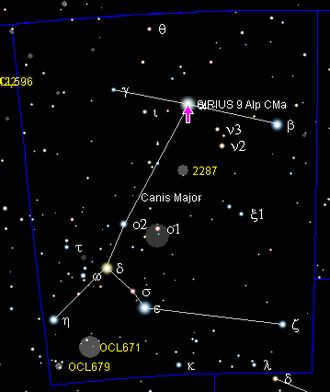
In ancient Chinese astronomy, Sirius was known as Lan, which means “Wolf,” or Tianlan, which means “Heavenly Wolf.” According to Sima Qian, when the planet Venus appears white, it is like Sirius, and when it appears reddish, it is like Antares [28]. [28] Sima Qian also stated that when the color of the rays from Sirius changes, there is an increase in theft and robbery on Earth [29]. However, Sima Qian’s claims about the changing colors of stars should be approached with caution.
Astronomers have dismissed the idea that evolutionary processes on one of the two stars caused a change in the color of Sirius, stating that a few thousand years is too short a time for such changes to occur. Additionally, no nebula has been observed in the system, which would be expected if such a drastic change had occurred. An alternative explanation could be that the term “red” is simply a poetic metaphor for the star’s ominous nature. It is also possible that the star’s intense flickering, particularly when it rises or sets near the horizon, created an illusion of a red color for those who observed it [30].
In 1718, Edmund Halley discovered the motion of Sirius, along with Aldebaran and Arcturus, by comparing Ptolemy’s ancient catalog of the night sky with observations from the 18th century. Although Sirius, Aldebaran, and Arcturus do not have the highest speeds of motion, Alpha Centauri was not visible in Europe due to its position in the southern sky, and Barnard’s star had not yet been discovered in the 18th century because it had a low apparent brightness.
Discovery of Sirius B [ edit correct code ]
The detection of Sirius B, also known as the “Pup,” was a significant astronomical achievement. This discovery, made in the early 19th century, provided evidence for the existence of white dwarf stars and deepened our understanding of stellar evolution. The credit for this breakthrough goes to Friedrich Wilhelm Bessel, a German astronomer who accurately predicted the presence of a companion to Sirius, the brightest star in the night sky. Bessel’s calculations were based on the irregular motion of Sirius, which suggested the gravitational pull of an unseen companion. His hypothesis was confirmed when Alvan Clark, an American telescope maker, observed Sirius B in 1862. This observation not only validated Bessel’s predictions but also demonstrated the power of scientific reasoning and observation in unraveling the mysteries of the universe. The discovery of Sirius B remains an important milestone in the history of astronomy, highlighting the perseverance and ingenuity of scientists in their quest for knowledge about the cosmos.
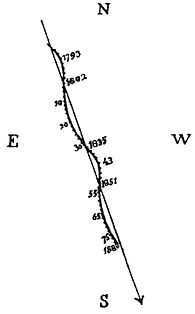
In 1844, Friedrich Bessel, a renowned astronomer and mathematician from Germany who served as the director of the Königsberg Observatory, made an intriguing discovery. He observed that the path of Sirius, a star in the sky, deviates slightly from a straight line at regular intervals. When viewed on the celestial sphere, this deviation took the form of a peculiar wave-like curve. This phenomenon is known as the proper motion of Sirius, which is quite significant at 1.3 angular seconds per year. Due to the relatively short observation period, these deviations from a straight trajectory could be accurately measured and recorded.
According to Bessel, the “wiggle” observed in Sirius’s motion was caused by the presence of a hidden mass. This mass, together with Sirius, orbits around a common center of mass with a period of 50 years. However, this idea was met with skepticism as it implied that the mass of the dark satellite should be roughly the same as the mass of the Sun [31].
Eighteen years later, in January 1862, Bessel’s hypothesis was proven to be correct. While testing an 18-inch (46-centimeter) refractor, the American astronomer Alvan Graham Clark discovered a small star near Sirius. Further observations revealed that this star was indeed orbiting Sirius as predicted by Bessel’s calculations. This discovery was a major triumph for gravitational astronomy and is considered to be on par with the discovery of Neptune [23].
Sirius B, with an apparent luminosity of 8.4 m, can be observed even in a small telescope when it is at the greatest distance from Sirius A (11 arc seconds). However, it becomes challenging to observe when it is in close proximity to Sirius A. This star holds the distinction of being the first white dwarf to be identified, although 40 Eridanus B was actually discovered earlier (however, it was not known to be a white dwarf at the time). With its significant mass, Sirius B ranks among the most massive white dwarfs ever found.
Location and conditions for observing Sirius [ edit edit code ] .
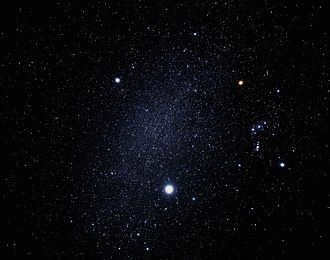
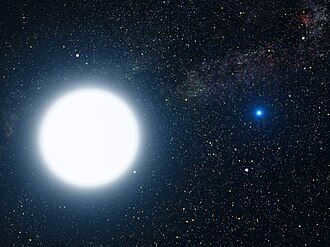
Sirius, a celestial body located in the southern part of the sky, possesses a unique characteristic. Despite its low declination, Sirius can still be observed in locations as far north as 73°N, including the Russian cities of Murmansk, Verkhoyansk, and Norilsk. Moreover, Sirius rises above the horizon to a sufficient height for visibility even in latitudes as far as Petrozavodsk.
In the middle latitudes of Russia, Sirius can be spotted in the southern part of the sky. During the autumn season, it becomes visible in the morning, while in winter it remains visible throughout the night. As for spring, it can still be observed for a certain period after sunset. In the summer months, however, Sirius is concealed within the Sun’s rays and cannot be sighted from Russian territory. It can only be seen from the middle latitudes of the Southern Hemisphere, where the Sun rises later and sets earlier than Sirius, with Sirius appearing lower above the horizon. Nevertheless, due to its brightness, Sirius can still be observed during the daytime, provided that the atmosphere is clear and its location in the sky is known. Additionally, it stands out in photographs of the daytime sky, particularly when taken in mountainous regions.
Sirius is ranked as the sixth most luminous celestial body in the Earth’s atmosphere. Only the Sun, the Moon, and the planets Venus, Jupiter, and Mars surpass Sirius in terms of brightness during its peak visibility period (refer to the List of Brightest Stars).
The primary point of reference for observation is the Orion’s belt. A direct line drawn through it indicates the northwest direction, where Aldebaran is situated, while the opposite side points to the southeast, where Sirius can be found. Even without a comprehensive knowledge of cardinal directions, it is impossible to mistake Sirius and Aldebaran due to their distinctive differences in color and luminosity [23].
If one is familiar with the cardinal points, Sirius can be located using other stars as guides: Sirius is positioned southwest of the prominent star Procyon, approximately 35 degrees north of Canopus, about 30 degrees south of Alchena (γ Gemini), or 15 degrees east of Arneb (α Hare) [23].
Currently, Sirius can be easily seen in the Northern Hemisphere. However, in approximately 11,000 years, due to precession, Sirius will no longer be visible in Europe. In addition, the Big Dog constellation will shift towards the polar region, as the South Pole of the world will be located in the Sails or Dove constellation. Meanwhile, the North Pole of the world will be near the star Vega. It is worth noting that ancient European civilizations, about ten thousand years ago, were unaware of Sirius. Instead, they were able to observe Centauri and Toliman together, as they battled with the Wolf. Additionally, they could see the Southern Cross in the feet of Centauri [16].
Sirius has a notable motion of its own. Once it completes a full precession cycle, which takes around 25,776 years, Sirius will have moved quite far from its current position and will have shifted towards the southwest. It will then be situated roughly halfway between the stars Mirtsam and Furid (ζ Big Dog) and will only be easily visible to the south of central Russia.
Meanwhile, approximately 26,000 years ago (around 24,000 BC), Sirius was positioned near the center of the present-day constellation Unicorn [33].
The primary features of the star [ edit edit code ]

The star known as Sirius has a measured brightness of -1.47 m and holds the distinction of being the most luminous star in the constellation of Canis Major, as well as the brightest star visible in the entire night sky. In the Northern Hemisphere, Sirius can be seen as the top point of the Winter Triangle [34] (the other two points being the brilliant stars Betelgeuse and Procyon). Sirius outshines even the closest star to our Sun, Alpha Centauri, as well as supergiants like Canopus, Rigel, and Betelgeuse. With knowledge of the specific coordinates of Sirius in the celestial sphere, it is possible to observe the star without the aid of a telescope, even during daylight hours. For optimal viewing conditions, the sky should be exceptionally clear and the Sun should be low on the horizon [35]. The nearest stellar system to Sirius is Procyon, which is located 5.24 light-years (1.61 parsecs) away [36].
Sirius A and B are two of the nearest stars to our Sun, located about 8.6 light-years away (2.6 pc). In terms of their distance from Earth, Sirius is ranked seventh among all stars, and it holds the top spot as the brightest star visible from our planet. The reason why Sirius shines so brightly is because of its proximity to us. If Sirius were situated 10 pc away from the Sun, it would still be a prominent star with an apparent luminosity of 1.8 m, making it the brightest star in the Big Dipper.
At present, Sirius is moving closer to our Solar System at a speed of 7.6 km/s [12], which means that its apparent brightness will gradually increase in the future.
The Sirius System [ edit edit code ]
Sirius is a binary star system composed of an A1 spectral class star (Sirius A) and a white dwarf (Sirius B) circling a common center of mass with a orbital period of approximately 50 years. The average separation between these stars is about 20 astronomical units (a. e.), which is equivalent to the distance from the Sun to Uranus. The system’s age falls within the range of 225-250 million years [22]. The IRAS space observatory has detected an excess of infrared radiation emanating from the Sirius system, which suggests the presence of dust within the system [37].
The mass of Sirius A is approximately equivalent to 2 times the mass of the Sun. When measured using interferometry, the star’s angular diameter is determined to be (5.936 ± 0.016) × 10 -3 angular seconds in the flat disk model. However, when accounting for darkening at the edge, the angular diameter increases to (6.039 ± 0.019) × 10 -3 angular seconds, which is equivalent to a linear size of 1.7 times the size of the Sun. Despite this, the projection of Sirius A’s rotation velocity onto the line of sight is relatively small at 16 kilometers per second, giving it an almost spherical shape [38].
Sirius A is expected to remain on the main sequence for approximately 660 million years. After this, it will undergo expansion and become a red giant before shedding its outer shell and transforming into a white dwarf [22].
Sirius B, a white dwarf star, possesses a mass equivalent to that of the Sun. This makes it one of the most massive white dwarfs, as a typical white dwarf only has a mass of approximately 0.6-0.7 solar masses [39]. Despite its mass, Sirius B has a volume over a million times smaller than the Sun, resembling the size of a globe. Prior to becoming a white dwarf, this star underwent various stages of development, starting with the main-sequence phase and progressing to the red giant stage. It is estimated that the shedding of Sirius B’s outer layers occurred around 120 million years ago. During its main-sequence stage, Sirius B had a mass of 5 solar masses and belonged to the B4 or B5 spectral class. The spectrum of Sirius B indicates a predominance of hydrogen [7].
While going through the red giant phase, it is believed that Sirius B has likely augmented the metal content of the star Sirius A. The spectrum of Sirius A demonstrates a significant metallicity – the iron level in the atmosphere of Sirius A is 316% of the solar level, and the spectrum also reveals the existence of other elements that are more massive than helium [7].
Nearby surroundings of Sirius [ edit edit code ]
The nearest star to Sirius is Procyon [40], with a distance of 5.2 light-years between the two stars. The Sun is also one of the nearest stars (sixth in terms of distance) to Sirius.
Coordinates: 06 h 45 m 08.9173 s -16° 42′ 58.017″ Sirius (Latin. Sirius), also known as α of the Big Dog (Latin. α Canis Majoris), stands out as the most brilliant star in the night sky. While its luminosity is 22 times that of the Sun, it does not hold the record in the stellar world – Sirius appears exceptionally bright due to its relative proximity. Sirius can be observed from any part of the Earth, except for the most northern regions. It is located 8.6 light-years away from the solar system and is one of the closest stars to us. Sirius is a main-sequence star with a spectral class of A1.
In 1844, Friedrich Bessel proposed the idea that Sirius was actually a binary star system. Fast forward to 1862, and Alvan Clarke made a groundbreaking discovery when he found another star in the system, which was subsequently named Sirius B (commonly referred to as Sirius B). The primary star in the system is often called Sirius A. These two stars have an orbital period of approximately 50 years and revolve around a shared center of mass at a distance of about 20 astronomical units. It’s worth noting that in 1915, astronomers at Mount Wilson Observatory determined that Sirius B is a white dwarf, making it the first white dwarf ever discovered. This finding suggests that Sirius B must have been significantly more massive than Sirius A in the past, as it had already transitioned away from the main sequence during its evolution.
According to the latest research, Sirius is estimated to be around 230 million years old, with estimates ranging from 200 to 300 million years. Initially, Sirius was composed of two blue-white stars belonging to the spectral class B. One of the stars had a mass of 5 times that of the Sun, while the other had a mass of 2 solar masses (Sirius B and Sirius A). Eventually, the more massive star, Sirius B, underwent nuclear fusion and transformed into a red giant. Subsequently, it shed its outer layers and evolved into its current state as a white dwarf [2]. Currently, Sirius A has a mass approximately twice that of the Sun, while Sirius B has a slightly smaller mass than the Sun.
History [ edit ] .
Sirius held great significance in many ancient civilizations. In the Nile River Valley, it was worshipped during the Early Kingdom as the goddess Sopdet (known as Sotis in Greek), believed to be the celestial embodiment of Isis. Depictions often showed Sirius as Isis standing in a celestial boat, with a five-pointed star above her head, while Osiris stood to her right, symbolizing the stars of Orion’s belt. Hathor, the goddess depicted as a cow, was also associated with Sirius, with the star positioned between her horns. The heliacal rising of Sirius, observed after its 70-day disappearance from the sky, allowed Egyptian priests to accurately predict the start of the Nile flood. In ancient Egypt, the calendar year was determined by the period between two heliacal rising of Sirius [3].
In ancient Sumero-Akkadian astronomy, the star known as Arrow was closely associated with the god Ninurta [4]. An inscription on the monument of Tiglathpalasar I (11th century BC) states: “During the days of cold, frost, and ice, when the star Arrow appears, it shines with a fiery red color resembling copper.” This description refers to the acronical rising of Sirius, which occurred in the middle of winter during the Middle and New Assyrian periods [5].
The modern name for Sirius originated from the Latin transcription “Sirius,” derived from the Greek word Σείριος, meaning “bright” or “brilliant.” Throughout history, Sirius has been commonly referred to as the Dog Star, alongside Procyon. Procyon and Sirius have both been recognized as the two prominent “dog” stars [6].
As per Greek mythology, the star Sirius was known as the dog Orion or Icaria. In the Iliad (XXII 30), Homer refers to it as “Orion’s Dog”. The ancient Greeks also connected Sirius with the scorching heat of summer: the star’s name originates from a term signifying “hot day”. According to the 3rd-century B.C. Greek poet Aratus, it earned this title due to its ability to shine “with an exceptionally radiant luminosity” [7].
The Latin term for Sirius is “vacation” which translates to “little dog”. In ancient Rome, the period of intense summer heat that coincided with the beginning of Sirius’ morning visibility was referred to as “dies caniculares” or “dog days”. This is the origin of the word “vacation”. Furthermore, the Russian translation of Sirius is “psitsa”, as mentioned in the XVI century book “Naziratel”.
There is an intriguing tale connected to Sirius. In ancient records, Sirius was described as a red star, although its color has now transformed into a bluish-white hue. The renowned ancient Roman philosopher Seneca and the esteemed architect of the celestial system, Claudius Ptolemy, both regarded Sirius as a vivid red star rather than a blue one. Seneca argued that “the sky manifests an array of colors: the Dog shines in bright red, Mars appears dimmer, and Jupiter lacks any color, emitting only pure light” [11]. Ptolemy characterized Sirius as “the reddest, brightest star among all fixed stars, situated in the mouth of the Dog constellation” [11] [12]. References to red Sirius can also be found in the folklore of various other cultures.
In ancient Chinese astronomy, there was a star known as Lan (“Wolf”) or Tianlan (“Heavenly Wolf”). According to Sima Qian, when the planet Tai-bo (Venus) appears white, it is similar to the star Lan (Sirius), and when the planet appears reddish, it is similar to the star Xin (Antares) [13]. Sima Qian also noted that when the rays of Sirius change color, there tends to be an increase in theft and robbery on Earth [13] [14]. However, it is important to approach these claims with caution, as Sima Qian acknowledged that stars often change their colors.
Astronomers have dismissed the idea that the color of Sirius could have been changed by evolutionary processes on one of the two stars. They argue that a few thousand years is too short a time period for such a radical change to occur, and there is no observed nebula in the system that would indicate such a transformation. Another explanation could be that the term “red” is simply a poetic metaphor for the star’s bad omens. It is also possible that the intense twinkling of the star as it rose or set near the horizon created an impression of red color for those who observed it [15].
Edmund Halley discovered the motion of Sirius, Aldebaran, and Arcturus in 1718 by comparing Ptolemy’s ancient catalog of stars with observations from the 18th century. It is interesting to note that although these three stars do not have the highest speed of motion, Alpha Centauri was not visible in Europe due to its position in the southern sky, and Barnard’s star had not yet been discovered during Halley’s time because of its dim apparent brightness.
Uncovering Sirius B [ edit ]
In 1844, Friedrich Bessel, a renowned astronomer and mathematician from Germany and the head of the Königsberg Observatory, made a groundbreaking discovery. He observed that the path of Sirius occasionally veers off from a straight line, although the deviation is faint. When projected onto the celestial sphere, it took on the form of an unusual wave-like curve (Sirius exhibits a substantial proper motion of 1.3 angular seconds per year, allowing for the detection of deviations from a straight trajectory within a relatively short period of observation).
Bessel explained that the “wiggle” was caused by the influence of an unknown mass that was orbiting around Sirius with a period of 50 years. This idea was met with skepticism because it implied that the mass of the dark satellite should be similar to the mass of the Sun [16].
However, 18 years later in January 1862, Bessel’s hypothesis was brilliantly confirmed. American astronomer Alvan Graham Clark discovered a small star near Sirius while testing an 18-inch (46-centimeter) refractor. This star was found to have orbital motion that matched Bessel’s calculations, marking a triumph for the field of gravitational astronomy. The significance of this discovery was comparable to the finding of Neptune [9].
Sirius B possesses an apparent luminosity of 8.4 m. When it is furthest away from Sirius A, which is at a distance of 11 arc seconds, it is visible through a small telescope. However, when it is near Sirius A, it becomes challenging to observe. This particular star holds the distinction of being the first white dwarf ever discovered and is also one of the most massive white dwarfs to have been found [9].
Where to find Sirius and its observation conditions [ edit ] .
Sirius, the brightest star in the sky, can be found alongside Procyon, which is positioned above and to the left, as well as the constellation of Orion, which is situated to the right. Furthermore, a portion of the Milky Way can be clearly seen between Sirius and Procyon.
Sirius is located in the southern hemisphere of the celestial sphere. Despite its relatively small declination, Sirius can still be observed up to 73°N, even in northern Russian cities such as Murmansk, Verkhoyansk, and Norilsk. In fact, Sirius rises high enough above the horizon to be visible in Petrozavodsk and other cities at similar latitudes.
In the middle latitudes of Russia, Sirius can be observed in the southern part of the sky. During the autumn season, it becomes visible in the morning, while in winter it can be seen throughout the night. In spring, it remains visible for a certain period after sunset. However, during summer, Sirius becomes concealed by the Sun’s rays and cannot be seen from Russia. It can only be observed from the middle latitudes of the Southern Hemisphere, where the Sun rises later and sets earlier than Sirius, placing it lower on the horizon.
Sirius holds the sixth position in terms of brightness among all celestial objects visible from Earth. Only the Sun, the Moon, and the planets Venus, Jupiter, and Mars shine brighter than Sirius during its peak visibility period (see also: List of the brightest stars).
The primary point of reference for observation is the belt of Orion. By drawing a straight line through it, one can locate Aldebaran in the northwest and Sirius in the southeast. Even without knowledge of the cardinal directions, it is impossible to mistake Sirius and Aldebaran due to their distinct differences in color and brightness [9].
If one is familiar with the cardinal directions, Sirius can be found using other stars: it is situated southwest of the luminous star Procyon, approximately 35 degrees north of Canopus, roughly 30 degrees south of Alchena (γ Gemini), or 15 degrees east of Arneb (α Hare) [9].
Sirius is currently easily observable in the Northern Hemisphere, but due to the phenomenon of precession, in approximately 11,000 years, Sirius will no longer be visible in Europe. Additionally, the constellation Canis Major, which includes Sirius, will shift close to the celestial pole, while the South Pole of the Earth will be located within the constellations Vela or Columba. During this period, the North Pole of the Earth will be in close proximity to the star Vega. It is worth noting that ancient civilizations living in Europe around ten thousand years ago were also unaware of the existence of Sirius, but were able to observe the constellation Centaurus, along with the star Toliman, engaged in combat with the Wolf, and also had a view of the Southern Cross in its legs [2].
The proper motion of Sirius is quite significant. After completing a full precession cycle of 25,776 years, Sirius will have moved far from its current position, shifting towards the southwest. It will be positioned approximately halfway between the stars Mirtsam and Furid (ζ of the Big Dog), and will be easily observable only to the south of central Russia.
Meanwhile, approximately 25,776 years ago (around 24,000 BC), Sirius was situated in the center of the constellation Unicorn [17].
Main features of the star [ edit ]
Sirius possesses a apparent luminosity of -1.47 m and stands as the most brilliant star in the constellation of the Big Dog, as well as the most brilliant star in the entire nocturnal firmament. In the Northern Hemisphere, Sirius appears as the apex of the Winter Triangle [18] (the other apexes being the luminous stars Betelgeuse and Procyon). Sirius shines brighter than Alpha Centauri, the star closest to the Sun, and even outshines supergiants like Canopus, Rigel, and Betelgeuse. Under favorable conditions, with a clear sky and a low Sun on the horizon [19], Sirius can even be visible to the naked eye during daylight hours. The nearest star system to Sirius is Procyon, located 5.24 light-years (1.61 parsecs) away [20].
Sirius A and B are two of the nearest stars to Earth, located at a distance of 8.6 light-years (2.6 pc). In terms of proximity, Sirius is seventh on the list of stars closest to our planet, but it takes the top spot among the ten brightest stars visible from Earth. Despite not being highly luminous, Sirius appears bright to us because of its close proximity. If Sirius were situated 10 pc away from the Sun, its apparent luminosity would be 1.8 m, similar to the brightest star in the Big Dipper.
Currently, Sirius is moving towards the Solar System at a speed of 7.6 km/s, which means its brightness will gradually increase over time.
The Sirius system [ edit ]
The Sirius system is composed of two stars, one of which is a star called Sirius A with a spectral class of A1. The other star, called Sirius B, is a white dwarf. These stars orbit around a center of mass with a period of approximately 50 years. The average distance between Sirius A and Sirius B is around 20 astronomical units (a.u.), which is similar to the distance from the Sun to Uranus. Scientists estimate that the age of the Sirius system is between 225 and 250 million years [8]. Interestingly, the IRAS space observatory has detected an unusual amount of infrared radiation coming from the Sirius system compared to what was expected. This unexpected observation could suggest the presence of dust within the system [22].
The mass of Sirius A is approximately 2 times that of the Sun. The interferometric measurement of the star’s angular diameter in the flat disk model is (5.936 ± 0.016)×10 -3 angular seconds, and when accounting for darkening towards the edge, the angular diameter is (6.039±0.019)×10 -3 angular seconds, equivalent to a linear size of 1.7 times that of the Sun. The velocity of rotation of Sirius A around its axis at the equator, projected onto the line of sight, is relatively small at 16 kilometers per second, indicating an almost spherical shape [23].
Sirius A will remain on the main sequence for approximately 660 million more years, after which it will enter the red giant phase, shed its outer shell, and transform into a white dwarf [8].
Sirius B is an extremely massive white dwarf, with a mass of approximately 1 solar mass. Most white dwarfs have a mass ranging from 0.6 to 0.7 solar masses [24], making Sirius B stand out as one of the largest white dwarfs in existence. Despite its high mass, Sirius B is incredibly compact, with a volume over a million times smaller than that of the Sun, resembling the size of a small globe. Prior to becoming a white dwarf, Sirius B went through several stages of stellar evolution, starting with the main-sequence stage and later transitioning into the red giant stage. It is estimated that Sirius B shed its outer envelope around 120 million years ago. During its main-sequence stage, the star had a mass of 5 solar masses and a spectral class of B4 or B5. The spectrum of Sirius B reveals a nearly pure hydrogen composition [25].
While going through the red giant phase, Sirius B is believed to have infused metals into the star Sirius A. The spectrum of Sirius A indicates a significant metallicity – the iron concentration in the atmosphere of Sirius A is 316% of the solar concentration, and the spectrum also implies the existence of other elements that are heavier than helium [25].
Sirius’ nearest vicinity [ edit ] .
The nearest star to Sirius is Procyon [26] , with a separation of 5.2 light-years between them. The Sun is also among the closest stars (sixth in terms of distance) to Sirius.
Comprehensive catalog of all stars located within a 10-light-year radius of Sirius:
| Star | Spectral class | Distance, sv. years |
| Procyon | F5 V-IV ; DA-F/VII | 5.2 |
| Ross 614 | M4.5 Ve ? | 5.5 |
| Leuthen’s Star | M3.5-5 Ve | 5.8 |
| Kapteyn’s star | M0-1.5 VI | 7.5 |
| Epsilon Eridanus | K2 V | 7.8 |
| Sun | G2 V | 8.6 |
| LHS 1565 | M5.5 V | 8.9 |
| Wolf 359 | M5.8 Ve | 9.0 |
| DX Cancer | M6.5 Ve | 9.2 |
| Proxima Centauri | M5.5 Ve | 9.3 |
| Alpha Centauri | G2 V ; K0 V | 9.5 |
| LTT 12352 | M3.5 V | 9.9 |
Sirius supergroup [ edit ]
At one point, Sirius was regarded as a prominent member of the dynamic group within the constellation Ursa Major. This particular group comprises 220 stars that share a common age and exhibit similar movement in space. Initially, it was believed that this group formed a cohesive star cluster, but over time, it disintegrated and lost its gravitational coherence [27]. Consequently, the majority of the stars in the well-known asterism known as the Big Dipper are associated with this disintegrated cluster. However, subsequent research has led scientists to conclude that Sirius is actually much younger than this cluster and therefore cannot be considered its representative [28].
Simultaneously, researchers have proposed that Sirius, in conjunction with Ascendant’s β star, Gemma (α of the Northern Crown), the Cup’s β star, Cursa (β of Eridanus), and the Serpent’s β star, could potentially serve as a representation of the hypothetical Sirius super cluster [29]. This particular cluster is among three expansive star clusters (if it indeed exists) situated within 500 light years of the Sun. The Hyades and the Pleiades are the other two clusters of this kind [30].
The Role of Sirius in World Mythology
Sirius, known for its brilliance in the night sky, has captivated the minds of humans throughout history and is a prominent figure in various myths and legends.
The Maori legends revered a divine entity residing in the celestial realm, specifically in the tenth heaven, known as Rehua. Rehua was connected to certain stars, with each tribe attributing a different star to this mythical being. The Tuhoe people of the North Island of New Zealand associated Antares with Rehua, while for many others, the brightest and most knowledgeable star in the sky, Sirius, held this association. As Rehua dwelled in the highest heavenly realm, he was immune to mortality, possessing the power to resurrect the deceased and heal any affliction. Numerous Maori individuals held the belief that witnessing Sirius was akin to encountering Rehua, the most sagacious entity in the cosmos [31]. The Quran similarly acknowledges the presence of Sirius in Ayat 53:49 [32].
Additional References
Important Details
- ↑ The distance is calculated based on the given parallax value.
- ↑ 2,02,1 Astronomy // Encyclopedia for Children. – Moscow: Avanta+, 2007.
- ↑Holberg, 2007, pp. 4, 6.
- ↑Kurtik G. E. Starry sky of ancient Mesopotamia. – St. Petersburg. , 2007. – С. 248.
- ↑Kurtik G. E. Op. cit. – P. 245.
- ↑Henry G. Liddell, Robert Scott. Greek-English Lexicon, Abridged Edition. – Oxford University Press, 1980. – ISBN 0-19-910207-4.
- ↑ Aratus. Apparitions. – SPb. , 2000. – С. 78.
- ↑ 8,08,18,2Holberg J. B.Sirius: Brightest Diamond in the Night Sky = Sirius: Brightest Diamond in the Night Sky. – Chichester, UK: Praxis Publishing, 2007. – P. 22, 214, 218. – ISBN 0-387-48941-X.
- ↑ 9,09,19,29,39,4Siegel, F. Yu. Treasury of the starry sky – a guide to the constellations and the Moon / Edited by G. S. Kulikov. – 5th edition. – Moscow: Nauka, 1986. – Pages 126-128. – 296 pages. – 200,000 copies.
- ↑ Dictionary of the Russian language of the 11th-17th centuries. Issue 21 / Edited by G. A. Bogatova. – Moscow: Nauka, 1995. – Page 36.
- ↑Seneca. On Nature I 1, 7 // Philosophical Treatises / Translated by T. Y. Borodai. – St. Petersburg, 2001. – Page 186.
- ↑Claudius Ptolemy. Almagest / Translated from Ancient Greek by I. N. Veselovsky. – Moscow: Nauka. Fizmatlit, 1998. – Page 256. – 672 pages. – ISBN 5-02-015167-X.
- ↑Sima Qian. Chapter 27 // Historical Notes. – Moscow, 1986. – Volume 4. – Page 133.
- ↑Sima Qian. op. cit. op. cit. – Page 120.
- ↑Whittet D. C. B. A physical explanation of the “red Sirius” phenomenon // Monthly Notices of the Royal Astronomical Society. – 1999. -,. – P. 355-359. — DOI:10.1046/j.1365-8711.1999.02975.x.
- ↑Shklovsky I. S. Stars: their origin, life, and demise. – 1984.
- ↑Calculation performed in the “Stellarium” program
- ↑Star positioned above us. “Open College. Verified on September 18, 2008.Archived from the original source on August 17, 2011.
- ↑Henshaw C.On the Visibility of Sirius in Daylight // Journal of the British Astronomical Association. – 1984. -,. – P. 221-222.
- ↑Sirius 2 . SolStation. Verified on September 6, 2008.Archived from the original source on August 17, 2011.
- ↑Citation error: Invalid tag; no text for SIMBAD footnotes
- ↑Backman, D. E. (June 30-July 11, 1986). “Observations of nearby main sequence stars and modeling of excess infrared emission”. Proceedings, 6th Topical Meetings and Workshop on Cosmic Dust and Space Debris, Toulouse, France: COSPAR and IAF. ISSN 0273-1177. Checked September 20, 2008.
- ↑Kervella P. et al. Interferometric diameter and internal structure of Sirius A = The interferometric diameter and internal structure of Sirius A // Astronomy and Astrophysics. – 2003. -. – P. 681-688. — DOI:10.1051/0004-6361:20030994.
- ↑Kepler S. O. et al. The distribution of white dwarf masses derived from the Sloan Sky Survey is examined in the article titled “White dwarf mass distribution in the SDSS” published in the Monthly Notices of the Royal Astronomical Society in 2007. The article can be found on pages 1315-1324 and has a DOI: 10.1111/j.1365-2966.2006.11388.x. It is also available on arXiv:astro-ph/0612277v2.
- ↑An error occurred in the citation. The tag is invalid and there is no text for footnotes AJL1.
- ↑The list of stars closest to Sirius.
- ↑Hartmut Frommert, Christine Kronberg. The Ursa Major Moving Cluster, also known as Collinder 285, is discussed in this article. Unfortunately, the link to the article is unavailable, but it can be accessed through the SEDS website (Archived from the original source on December 20, 2007). The information was verified on November 22, 2007.
- ↑ Jeremy R. King, Adam R. Villarreal, David R. Soderblom, Austin F. Gulliver, Saul J. Adelman (2003). "Reevaluating the Membership, Activity, and Age of the Ursa Major Group". Astronomical Journal15 (4): 1980-2017. DOI:10.1086/368241. Verified on November 22, 2007.
- ↑Olin J. Eggen. The Sirius supercluster in the FK5 catalog = The Sirius supercluster in the FK5 catalog. – 1992. -,. – P. 1493-1504. – DOI:10.1086/116334.
- ↑Olano C. A. Investigating the Origin of the Local System of Gas and Stars. – 2001. -. – P. 295-308. – DOI:10.1086/318011.
- ↑ Te Maire Martin, The Concise Encyclopedia of Māori Myth and Legend (Canterbury University Press: Christchurch), 2007.
- ↑ Surah 53. al-Najm "The Star", verse 49.
Literature [ edit ]
- J. B. Holberg Sirius: The Shiniest Gem in the Night Sky. – Springer – Praxis, 2007. – 250 p. – ISBN 978-0-387-48941-4.
- Noah Brosch. Sirius: A Matter of Importance. – Spinger, 2008. – 216 p. – ISBN 978-1-4020-8318-1.
| The following table presents a compilation of star systems located within a distance of 0-10 light-years from Earth. These systems include the brightest member with an absolute stellar magnitude of +8.5 or higher. | |
| Sirius (8.58±0.03 light-years; 2 stars: Sirius A – Sirius B) | |
| The Solar System (0 light-years; 1 star and 8 planets) – Alpha Centauri (4.365±0.007 light-years; 3 stars: α Centauri A – α Centauri B – Proxima Centauri (4.242±0.002 light-years)) | |

